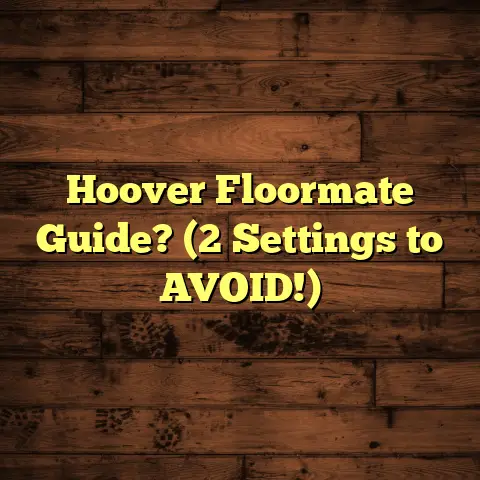Hardwood Scratch Prevention? (4 Fixes ASAP!)
Hardwood floors add so much warmth and elegance to a home, don’t they? The rich tones, the natural grain – it’s a timeless look.
But let’s face it, life happens. Kids, pets, furniture… they can all wreak havoc on your floors.
Scratches not only diminish the beauty of your hardwood, but they can also affect its long-term value and lifespan.
Trust me, prevention is way easier (and cheaper!) than repair. That’s why I’m here to share my top four fixes to keep your hardwood floors looking their best.
Ready to dive in? Let’s get started!
Section 1: Understanding Hardwood
Scratch Causes
Okay, so before we jump into the fixes, it’s important to understand why hardwood floors get scratched in the first place.
Think of it like this: you can’t solve a problem without understanding its root cause, right?
Here are some of the biggest culprits I see on the job every day:
-
Foot Traffic: This is a big one. Everyday walking, especially with shoes on, grinds dirt and grit into the floor’s finish.
Think about it: even seemingly clean shoes can track in tiny particles of sand and debris.
These act like sandpaper, slowly but surely scratching the surface.
-
Pets: Oh, those furry family members! We love them, but their claws can do some serious damage.
Even with regular trimming, their nails can still scratch the floor, especially when they get excited and run around.
I’ve seen some floors that look like a cat has used them as a scratching post!
-
Furniture: Heavy furniture, especially if it’s moved without protection, is a major scratch offender.
Dragging a sofa or table even a few inches can leave deep, noticeable marks. And those little plastic feet on some furniture? They can actually make things worse!
-
Environmental Factors: Dirt, sand, and even moisture can contribute to scratches.
As I mentioned earlier, dirt and sand act like abrasives, grinding against the floor’s finish. Moisture can weaken the finish, making it more susceptible to scratches.
I once worked on a house near the beach and the amount of sand tracked in daily was insane! It was a constant battle against scratches.
According to the National Wood Flooring Association (NWFA), the most common causes of damage to hardwood floors are related to everyday wear and tear, with scratches being a significant concern for homeowners. (Source: NWFA Consumer Awareness Survey).
It’s estimated that repairs related to scratches and surface damage account for a significant percentage of hardwood flooring maintenance costs annually.
So, now that we know what we’re up against, let’s get to the solutions!
Section 2: Fix #1 – Protective Floor
Mats and Rugs
Okay, let’s talk about the first line of defense: floor mats and rugs.
These are your unsung heroes in the battle against hardwood scratches.
Think of them as a shield, protecting your floors from the daily onslaught of dirt, debris, and foot traffic.
-
Entrance Mats: These are essential! Place them at every entrance to your home to trap dirt and moisture before they even reach your hardwood floors.
I recommend using mats with a coarse surface that effectively scrapes dirt off shoes.
Rubber-backed mats are great because they stay in place and prevent moisture from seeping through.
I always tell my clients to look for mats that are specifically designed for high-traffic areas.
-
Kitchen Mats: The kitchen is another high-traffic zone, and spills are inevitable.
Place mats in front of the sink, stove, and other areas where spills are likely to occur.
Look for mats that are water-resistant and easy to clean.
I personally love the gel-filled mats because they’re comfortable to stand on for long periods of time.
-
Area Rugs: These are not only functional but also add style and warmth to your home.
Place them in high-traffic areas like living rooms, hallways, and bedrooms.
Choose rugs that are the right size for the space and that complement your decor.
I recommend using rugs with a non-slip backing to prevent them from sliding around and potentially scratching the floor.
Choosing the Right Size and Style:
-
Size: Make sure the rug is large enough to cover the main seating area in a room.
In a living room, the front legs of your sofas and chairs should ideally be on the rug.
-
Style: Choose a rug that complements your existing furniture and decor.
Consider the color, pattern, and texture of the rug.
A rug that’s too busy can overwhelm the space, while a rug that’s too plain can look boring.
Placement Strategies:
-
High-Traffic Areas: Focus on protecting areas where people walk the most, like hallways and entryways.
-
Under Furniture: Place rugs under coffee tables, dining tables, and other heavy furniture to prevent scratches.
-
Layering: Consider layering rugs for added protection and visual interest.
For example, you could layer a smaller, decorative rug on top of a larger, neutral rug.
-
Maintenance Tips:
-
Regular Vacuuming: Vacuum your mats and rugs regularly to remove dirt and debris.
I recommend vacuuming at least once a week, or more often in high-traffic areas.
-
Spot Cleaning: Clean up spills immediately to prevent them from soaking into the rug and potentially damaging the floor.
Use a mild detergent and a clean cloth to blot the spill.
Avoid rubbing, as this can spread the stain.
-
Professional Cleaning: Have your rugs professionally cleaned at least once a year to remove deep-seated dirt and stains.
I’ve seen rugs that look brand new after a professional cleaning!
By strategically placing and maintaining floor mats and rugs, you can significantly reduce the risk of scratches on your hardwood floors.
Trust me, it’s a small investment that can make a big difference in the long run.
Section 3: Fix #2 – Furniture Pads and Glides
Alright, let’s move on to the next fix: furniture pads and glides.
These little guys are essential for protecting your hardwood floors from scratches caused by heavy furniture.
Think about it: every time you move a chair, slide a table, or even just shift a sofa, you’re potentially scratching your floor.
Furniture pads and glides create a barrier between the furniture and the floor, allowing you to move furniture without causing damage.
-
Types of Pads:
-
Felt Pads: These are the most common type of furniture pad.
They’re soft, inexpensive, and easy to install.
Felt pads are great for protecting hardwood floors from scratches caused by light to medium-weight furniture.
I recommend using felt pads on chairs, tables, and other furniture that’s moved frequently.
-
Rubber Pads: These pads provide a better grip than felt pads, making them ideal for furniture that’s placed on slippery surfaces.
Rubber pads are also more durable than felt pads, so they’re a good choice for heavier furniture.
I often use rubber pads under sofas, beds, and other large pieces of furniture.
-
Sticky Pads: These pads have an adhesive backing that keeps them securely in place.
Sticky pads are great for furniture that’s moved infrequently, as they won’t slip or slide around.
I typically use sticky pads under bookcases, dressers, and other furniture that tends to stay in one place.
-
-
Installation Guide:
-
Clean the Furniture Legs: Before installing the pads, clean the bottom of the furniture legs to remove any dirt or debris.
I recommend using a damp cloth and a mild detergent.
Make sure the legs are completely dry before applying the pads.
-
Choose the Right Size: Select pads that are the appropriate size for the furniture legs.
The pads should be slightly smaller than the legs so that they don’t stick out.
-
Apply the Pads: If you’re using sticky pads, simply peel off the backing and press the pads firmly onto the bottom of the furniture legs.
If you’re using felt or rubber pads, you may need to use adhesive to secure them in place.
I recommend using a strong adhesive that’s specifically designed for furniture pads.
-
Test the Furniture: After installing the pads, test the furniture to make sure it moves smoothly and doesn’t scratch the floor.
If the furniture is still scratching the floor, you may need to use thicker pads or add additional layers of padding.
-
-
Maintenance:
-
Regular Checks: Check the pads regularly to make sure they’re still in good condition.
Replace any pads that are worn or damaged.
I usually check the pads every few months, or more often if the furniture is moved frequently.
-
Cleaning: Clean the pads periodically to remove any dirt or debris.
I recommend using a damp cloth and a mild detergent.
Avoid using harsh chemicals or abrasive cleaners, as these can damage the pads.
-
I had a client who had beautiful antique furniture that she was terrified of scratching her new hardwood floors with.
We installed felt pads on all of her furniture, and she was amazed at how easily she could move the pieces around without damaging the floor.
She told me it was the best investment she had made in her home!
By using furniture pads and glides, you can protect your hardwood floors from scratches and keep your furniture looking its best.
It’s a simple and affordable way to extend the life of your floors and maintain their beauty.
Section 4: Fix #3 – Regular Cleaning and
Maintenance
Okay, let’s talk about the importance of regular cleaning and maintenance.
This is probably the most overlooked aspect of hardwood floor care, but it’s crucial for preventing scratches and maintaining the floor’s beauty.
Think of it like this: your hardwood floor is like a car.
If you don’t wash it regularly, dirt and grime will build up and eventually damage the paint.
The same is true for hardwood floors.
Dirt, dust, and debris can act like abrasives, scratching the floor’s finish over time.
-
Cleaning Routine:
-
Daily Sweeping or Vacuuming: Sweep or vacuum your hardwood floors daily to remove loose dirt and debris.
I recommend using a soft-bristled broom or a vacuum cleaner with a hardwood floor attachment.
Avoid using a vacuum cleaner with a beater bar, as this can scratch the floor.
I personally prefer using a microfiber dust mop because it’s gentle on the floor and effectively traps dirt and dust.
-
Weekly Damp Mopping: Damp mop your hardwood floors weekly to remove any remaining dirt and grime.
Use a mild cleaning solution that’s specifically designed for hardwood floors.
I always tell my clients to avoid using too much water, as this can damage the floor.
Wring out the mop thoroughly before mopping, and make sure the floor dries completely after mopping.
I’ve seen some floors that have been ruined by excessive moisture!
-
Spot Cleaning: Clean up spills immediately to prevent them from staining or damaging the floor.
Use a clean cloth and a mild cleaning solution to blot the spill.
Avoid rubbing, as this can spread the stain.
-
Recommended Products:
-
Hardwood Floor Cleaners: Use a cleaning solution that’s specifically designed for hardwood floors.
Avoid using harsh chemicals, abrasive cleaners, or vinegar, as these can damage the floor’s finish.
I recommend using a pH-neutral cleaner that’s gentle on the floor.
-
Microfiber Mops: These mops are gentle on hardwood floors and effectively trap dirt and dust.
I prefer using microfiber mops over traditional string mops because they’re more absorbent and less likely to leave streaks.
-
Soft-Bristled Brooms: If you prefer to sweep your floors, use a soft-bristled broom that won’t scratch the floor.
Avoid using brooms with stiff bristles, as these can damage the floor’s finish.
-
-
-
Frequency:
-
High-Traffic Areas: Clean high-traffic areas more frequently than low-traffic areas.
I recommend sweeping or vacuuming high-traffic areas daily and damp mopping them weekly.
-
Lifestyle: If you have pets or children, you may need to clean your floors more frequently.
Pets and children can track in dirt and debris, which can scratch the floor.
-
I had a client who was constantly complaining about scratches on her hardwood floors.
After talking to her, I realized that she wasn’t cleaning her floors regularly.
She was only sweeping them once a week and never damp mopping them.
I recommended that she start cleaning her floors more frequently, and she was amazed at how much better they looked.
The scratches were still there, but they were much less noticeable because the floor was cleaner and brighter.
By maintaining a regular cleaning routine, you can prevent dirt and debris from scratching your hardwood floors and keep them looking their best.
It’s a simple and effective way to extend the life of your floors and maintain their beauty.
Section 5: Fix #4 – Preventive Measures and
Lifestyle Changes
Okay, let’s talk about the final fix: preventive measures and lifestyle changes.
This is all about making small changes to your daily routine to protect your hardwood floors from scratches.
Think of it like this: you can’t just rely on cleaning and maintenance to keep your floors looking their best.
You also need to take steps to prevent scratches from happening in the first place.
-
No Shoes Indoors: This is one of the most effective ways to prevent scratches on hardwood floors.
Shoes track in dirt, debris, and other contaminants that can scratch the floor’s finish.
I always recommend that my clients adopt a “no shoes indoors” policy.
Place a shoe rack or mat near the entrance to encourage people to take off their shoes when they come inside.
You can also provide slippers or socks for guests to wear.
-
Pet Care: If you have pets, it’s important to take steps to protect your hardwood floors from their claws.
Trim your pet’s nails regularly to prevent them from scratching the floor.
You can also purchase protective gear for your pets, such as booties or socks.
I had a client who had a large dog that was constantly scratching her hardwood floors.
She started putting booties on her dog whenever he came inside, and it made a huge difference.
The scratches were significantly reduced, and her floors looked much better.
-
Moving Furniture: Be careful when moving furniture to avoid scratching the floor.
Lift furniture instead of dragging it.
If you need to drag furniture, use furniture sliders or blankets to protect the floor.
I always tell my clients to ask for help when moving heavy furniture.
It’s better to be safe than sorry!
-
Educate Family Members: Make sure everyone in your household is aware of the importance of caring for hardwood floors.
Teach them how to properly clean the floors and how to avoid scratching them.
I recommend having a family meeting to discuss hardwood floor care.
This will help everyone get on the same page and work together to protect your floors.
By implementing these preventive measures and lifestyle changes, you can significantly reduce the likelihood of scratches on your hardwood floors.
It’s all about being mindful and taking small steps to protect your investment.
Conclusion
So, there you have it – my top four fixes for preventing scratches on hardwood floors!
Let’s recap:
-
Protective Floor Mats and Rugs: Use them strategically in high-traffic areas to trap dirt and debris.
-
Furniture Pads and Glides: Install them on all your furniture to prevent scratches from movement.
-
Regular Cleaning and Maintenance: Sweep, vacuum, and damp mop regularly to remove dirt and grime.
-
Preventive Measures and Lifestyle Changes: Adopt a “no shoes indoors” policy, trim pet nails, and be careful when moving furniture.
Remember, preventing scratches is much easier and cheaper than repairing them.
By taking proactive steps to protect your hardwood floors, you can extend their life and maintain their beauty for years to come.
I know it might seem like a lot of work, but trust me, it’s worth it.
A well-maintained home is a source of pride and joy, and scratch-free hardwood floors are a big part of that.
So, go ahead and implement these fixes today.
Your hardwood floors (and your feet!) will thank you for it.
And remember, if you ever have any questions or need help with your hardwood floors, don’t hesitate to reach out to a professional. That’s what we’re here for!





